St. Louis encephalitis epidemiology and demographics: Difference between revisions
m (Changes made per Mahshid's request) |
|||
| (42 intermediate revisions by 4 users not shown) | |||
| Line 1: | Line 1: | ||
__NOTOC__ | __NOTOC__ | ||
{{St. Louis encephalitis}} | {{St. Louis encephalitis}} | ||
{{CMG}} {{AE}}: {{VVS}} | {{CMG}}; {{AE}} {{AG}}; '''Contributor(s):''' {{Irfan Dotani}}, {{VVS}} | ||
==Overview== | ==Overview== | ||
The [[incidence]] of St. Louis encephalitis is approximately 192 per 100,000 individuals worldwide. The majority of St. Louis encephalitis cases are reported in the United States. In the United States, the annual number of reported St. Louis encephalitis cases reported fluctuate widely, as a result of periodic [[epidemics]]. St. Louis encephalitis infection is thought to confer lifelong immunity against reinfection. The case fatality rate of St. Louis encephalitis ranges between 5-30%, with higher rates among the [[elderly]], worldwide.<ref name=SLEV>St. Louis Encephalitis. http://www.gcmad.org/Documents/St_Louis_Encephalitis.pdf Accessed July 28, 2016.</ref> St. Louis encephalitis affects men and women equally. There is no racial predilection to the development of St. Louis encephalitis.<ref name=SLEVCDC>Saint Louis Encephalitis. Centers for Disease Control and Prevention (2009). https://www.cdc.gov/sle/technical/fact.html Accessed July 28, 2016.</ref> Patients of all age groups may develop St. Louis encephalitis.<ref name=SLEV>St. Louis Encephalitis. http://www.gcmad.org/Documents/St_Louis_Encephalitis.pdf Accessed July 28, 2016.</ref> | |||
==Epidemiology and Demographics== | ==Epidemiology and Demographics== | ||
St. Louis encephalitis | ===Incidence=== | ||
The [[incidence]] of St. Louis encephalitis is approximately 192 per 100,000 individuals worldwide. The majority of St. Louis encephalitis cases are reported in the United States. In the United States, the annual number of reported St. Louis encephalitis neuroinvasive disease cases reported fluctuates widely, as a result of periodic [[epidemics]]. St. Louis encephalitis infection is thought to confer lifelong immunity against reinfection.<ref name=SLEVCDC>Saint Louis Encephalitis. Centers for Disease Control and Prevention (2009). https://www.cdc.gov/sle/technical/fact.html Accessed July 28, 2016.</ref> From 2004-2013, an average of 7 cases were reported annually.<ref name=SLEVCDC>Saint Louis Encephalitis. Centers for Disease Control and Prevention (2009). https://www.cdc.gov/sle/technical/fact.html Accessed July 28, 2016.</ref> | |||
[[File:SLEVND.png|900px|thumb|center|'''St. Louis encephalitis virus neuroinvasive disease cases reported by year, 1964-2010:''' In the United States, the number of St. Louis encephalitis cases reported each year vary. From 1964-2010, an average of 100 cases were reported annually.]] | |||
[[File:SLEVNDAAIBC.jpg|500px|thumb|center|'''St. Louis encephalitis virus neuroinvasive disease cases reported by year, 2004–2013:''' In the United States, the number of St. Louis encephalitis cases reported each year vary. From 2004-2013, an average of 7 cases were reported annually.]] | |||
===Case Fatality Rate=== | |||
The case fatality rate of St. Louis encephalitis ranges between 5-30%, with higher rates among the [[elderly]], worldwide.<ref name=SLEV>St. Louis Encephalitis. http://www.gcmad.org/Documents/St_Louis_Encephalitis.pdf Accessed July 28, 2016.</ref> | |||
===Age=== | |||
St. Louis encephalitis is a [[rare disease]] that tends to affect the [[elderly]] and patients <6 months of age. Patients of all age groups may develop St. Louis encephalitis.<ref name=SLEV>St. Louis Encephalitis. http://www.gcmad.org/Documents/St_Louis_Encephalitis.pdf Accessed July 28, 2016.</ref> | |||
===Race=== | |||
There is no racial predilection to the development of St. Louis encephalitis.<ref name=SLEVCDC>Saint Louis Encephalitis. Centers for Disease Control and Prevention (2009). https://www.cdc.gov/sle/technical/fact.html Accessed July 28, 2016.</ref> | |||
===Gender=== | |||
St. Louis encephalitis affects men and women equally.<ref name=SLEVCDC>Saint Louis Encephalitis. Centers for Disease Control and Prevention (2009). https://www.cdc.gov/sle/technical/fact.html Accessed July 28, 2016.</ref> | |||
In temperate areas of the United States, | ===Geographical Region=== | ||
[[ | In temperate areas of the United States, St. Louis encephalitis primarily occurs in late summer or early fall. In Southern states, where the climate is milder, cases may occur year round. Although the geographic range of the virus extends from Canada to Argentina, human cases have almost exclusively occurred in the United States. The majority of cases have occurred in Eastern and Central states, where episodic urban-centered [[outbreaks]] have recurred since the 1930s. The largest [[epidemic]] of St. Louis encephalitis occurred in the United States in 1975, with nearly 2,000 cases reported, primarily from the Central states in the Ohio-Mississippi River Basin.<ref name= SLEV&WN> Impact of the West Nile virus on the Natural History of St. Louis Encephalitis. (2008). http://scholarcommons.usf.edu/cgi/viewcontent.cgi?article=1437&context=etd Accessed on July 28, 2016.</ref> | ||
[[File:SLEVUSA.jpg|600px|thumb|center|'''St. Louis encephalitis cases reported by state, 1964-2010:''' From 1964-2010, St. Louis encephalitis cases have been reported across the United States. This chart illustrates the geographic distribution of the disease.]] | |||
[[File:SLE.jpg|700px|thumb|center|'''St. Louis encephalitis virus neuroinvasive disease cases reported by state, 2004–2013:''' From 2004-2013, St. Louis encephalitis cases have been reported across the United States. This chart illustrates the geographic distribution of the disease.]] | |||
[[File:SLEBC.jpg|530px|thumb|center|'''St. Louis encephalitis average annual incidence by county, 2004–2013:''' From 2004-2013, St. Louis encephalitis cases have been reported across the United States. This chart illustrates the geographic distribution of the disease by county, with a predominance of cases occurring in Southern states.]] | |||
==References== | ==References== | ||
{{ | {{Reflist|2}} | ||
[[Category:Neurology]] | |||
{{WS}} | |||
{{WH}} | {{WH}} | ||
Latest revision as of 19:07, 18 September 2017
|
St. Louis encephalitis Microchapters |
|
Diagnosis |
|---|
|
Treatment |
|
Case Studies |
|
St. Louis encephalitis epidemiology and demographics On the Web |
|
American Roentgen Ray Society Images of St. Louis encephalitis epidemiology and demographics |
|
St. Louis encephalitis epidemiology and demographics in the news |
|
Blogs on St. Louis encephalitis epidemiology and demographics |
|
Risk calculators and risk factors for St. Louis encephalitis epidemiology and demographics |
Editor-In-Chief: C. Michael Gibson, M.S., M.D. [1]; Associate Editor(s)-in-Chief: Anthony Gallo, B.S. [2]; Contributor(s): Irfan Dotani [3], Vishnu Vardhan Serla M.B.B.S. [4]
Overview
The incidence of St. Louis encephalitis is approximately 192 per 100,000 individuals worldwide. The majority of St. Louis encephalitis cases are reported in the United States. In the United States, the annual number of reported St. Louis encephalitis cases reported fluctuate widely, as a result of periodic epidemics. St. Louis encephalitis infection is thought to confer lifelong immunity against reinfection. The case fatality rate of St. Louis encephalitis ranges between 5-30%, with higher rates among the elderly, worldwide.[1] St. Louis encephalitis affects men and women equally. There is no racial predilection to the development of St. Louis encephalitis.[2] Patients of all age groups may develop St. Louis encephalitis.[1]
Epidemiology and Demographics
Incidence
The incidence of St. Louis encephalitis is approximately 192 per 100,000 individuals worldwide. The majority of St. Louis encephalitis cases are reported in the United States. In the United States, the annual number of reported St. Louis encephalitis neuroinvasive disease cases reported fluctuates widely, as a result of periodic epidemics. St. Louis encephalitis infection is thought to confer lifelong immunity against reinfection.[2] From 2004-2013, an average of 7 cases were reported annually.[2]
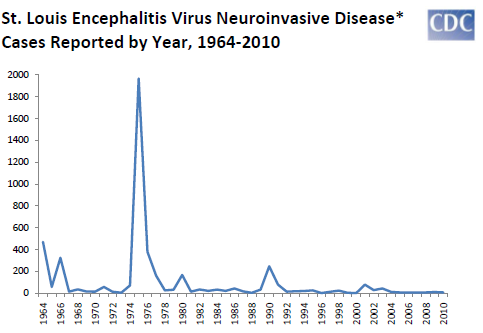
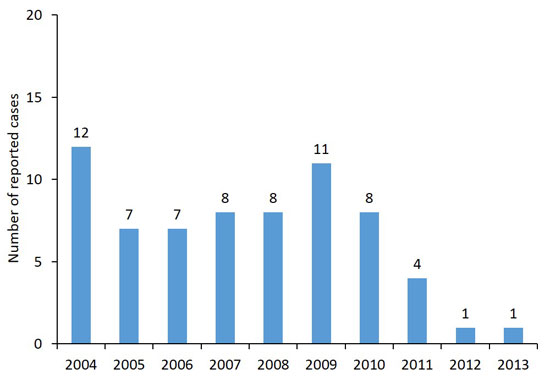
Case Fatality Rate
The case fatality rate of St. Louis encephalitis ranges between 5-30%, with higher rates among the elderly, worldwide.[1]
Age
St. Louis encephalitis is a rare disease that tends to affect the elderly and patients <6 months of age. Patients of all age groups may develop St. Louis encephalitis.[1]
Race
There is no racial predilection to the development of St. Louis encephalitis.[2]
Gender
St. Louis encephalitis affects men and women equally.[2]
Geographical Region
In temperate areas of the United States, St. Louis encephalitis primarily occurs in late summer or early fall. In Southern states, where the climate is milder, cases may occur year round. Although the geographic range of the virus extends from Canada to Argentina, human cases have almost exclusively occurred in the United States. The majority of cases have occurred in Eastern and Central states, where episodic urban-centered outbreaks have recurred since the 1930s. The largest epidemic of St. Louis encephalitis occurred in the United States in 1975, with nearly 2,000 cases reported, primarily from the Central states in the Ohio-Mississippi River Basin.[3]
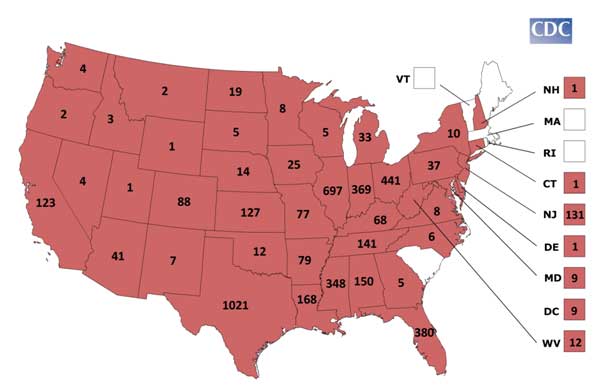
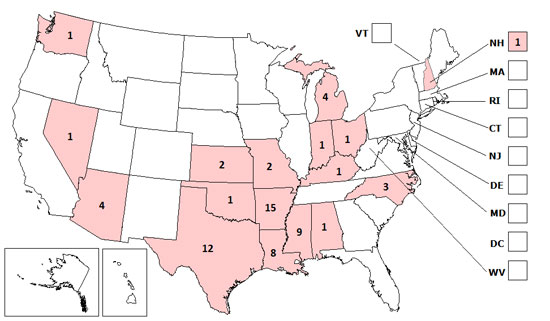
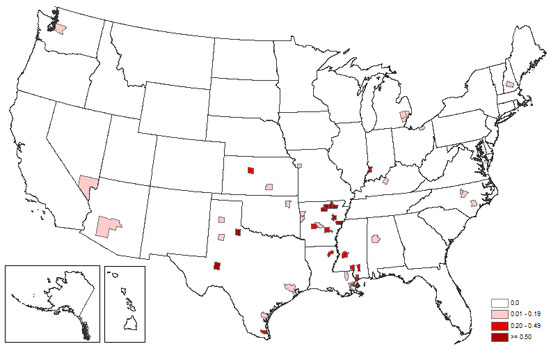
References
- ↑ 1.0 1.1 1.2 1.3 St. Louis Encephalitis. http://www.gcmad.org/Documents/St_Louis_Encephalitis.pdf Accessed July 28, 2016.
- ↑ 2.0 2.1 2.2 2.3 2.4 Saint Louis Encephalitis. Centers for Disease Control and Prevention (2009). https://www.cdc.gov/sle/technical/fact.html Accessed July 28, 2016.
- ↑ Impact of the West Nile virus on the Natural History of St. Louis Encephalitis. (2008). http://scholarcommons.usf.edu/cgi/viewcontent.cgi?article=1437&context=etd Accessed on July 28, 2016.